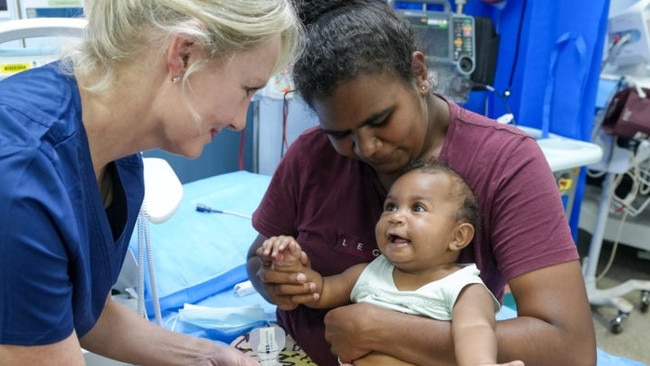Rural hospitals to drop city hospital transfers by 50%
Young children living in remote Far North communities will soon have access to specialist medical equipment after researchers discovered a new way to treat severe breathing difficulties.
News
Don't miss out on the headlines from News. Followed categories will be added to My News.
Young children living in remote Far North communities will soon have access to specialist medical equipment after researchers discovered a way to treat severe breathing difficulties.
High flow nasal oxygen therapy — a non-invasive breathing support device — has not been used for children under the age of five.
It has meant kids with respiratory issues have been transferred to ICU in Cairns following hours of high-intensity travel.
But now James Cook University researchers are going to teach the rural hospitals how to use the support device to avoid ICU transfers, saving up to $23,000 for each trip.

JCU’s Associate Professor Donna Franklin said it would save money, time and emotional trauma from the travel across Queensland.
“We really do believe this is going to reduce ICU transfers by 50 per cent,” she said.
“Right now, we have 50 per cent of all patients transferred to city hospitals ... we want to get that down to 25.”
The study is named ‘PARIS on the country’— paediatric acute respiratory intervention studies- and has been granted the funding to put high flow oxygen therapy in 18 rural hospitals in FNQ.
Dr Franklin is the chief investigator for the study and alongside clinical nurse, researcher and PhD student Sally Wells, will teach the hospitals how to use the equipment.
“The hospital order will be completely randomised which is a fair way to conduct this scientifically, with the first rural hospital seeing us in October,” she said.
“The complete heartache we see from parents who have travelled with their small children from the islands and the small communities up north is what drives us. We want to reduce that as much as we can.”
Ms West said the high flow oxygen therapy was rarely available in remote areas.
“We want to ease the pressure on stressed rural and remote EDs and we estimate savings at more than $6 million a year. Perhaps most importantly, it keeps children near their families and homes,” she said.
“This is a service parents in remote communities are desperate to see introduced. Having a child with breathing difficulties is stressful, but needing to transfer them unnecessarily away from country can be devastating, particularly for Indigenous families.”
The study will run for five years and after that time, all hospitals will be able to keep the equipment.
“We will be measuring the stats, we want this to be extremely effective,” Dr Franklin said.
Lead researcher and senior author of PARIS a project Dr Andreas Schibler said after conducting more than 180 different studies on respiratory, he’s optimistic.
“I’m optimistic that not only will it reduce numbers, but it will bring peace to a lot of the families,” he said.
“Families have been expressing that they need these facilities here for years, I’m glad we’re finally able to provide that help.”
More Coverage
Originally published as Rural hospitals to drop city hospital transfers by 50%




